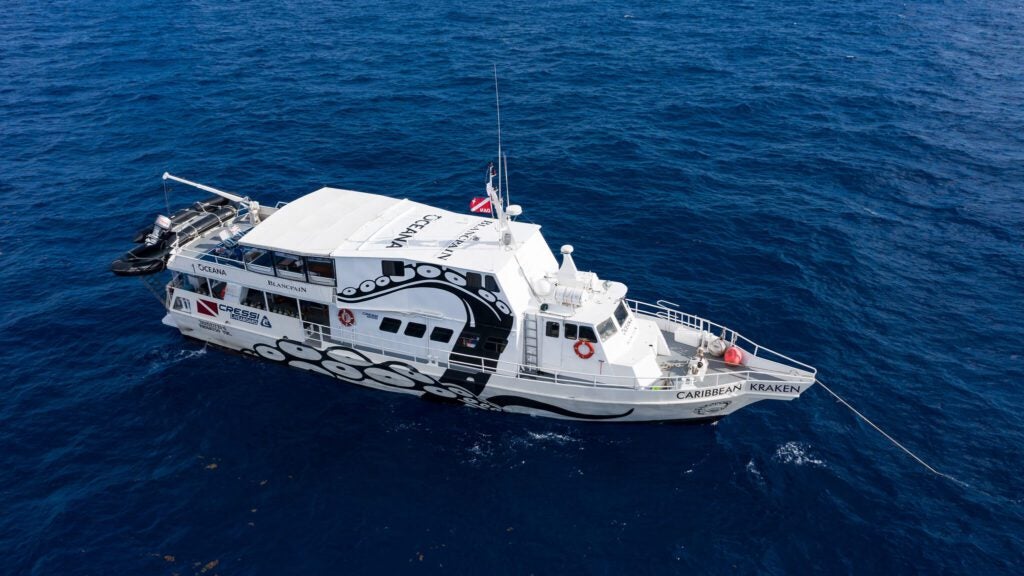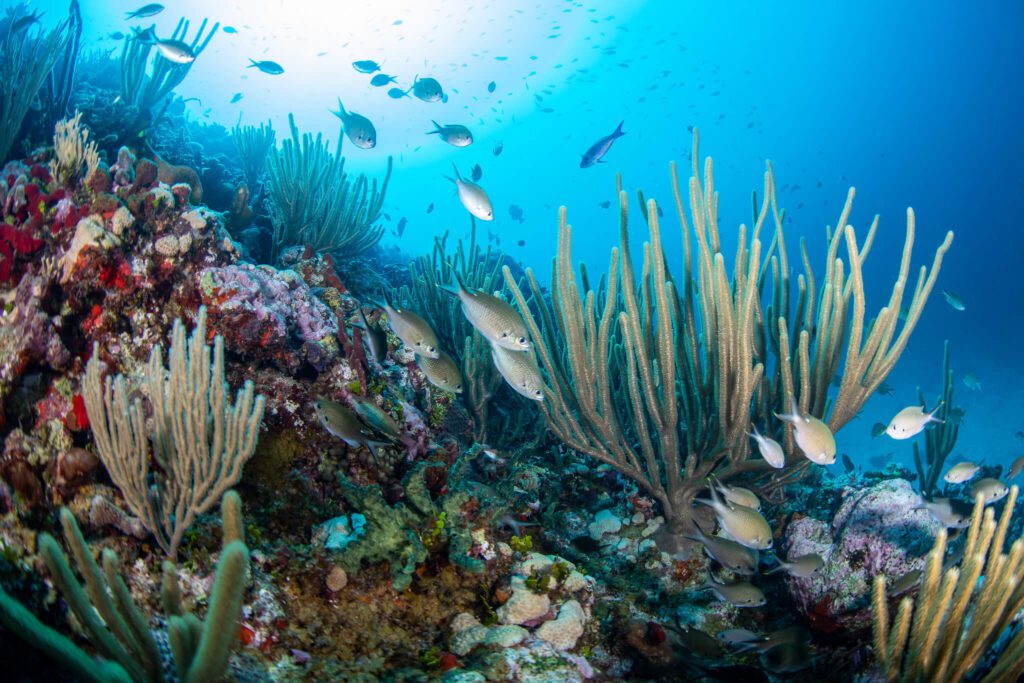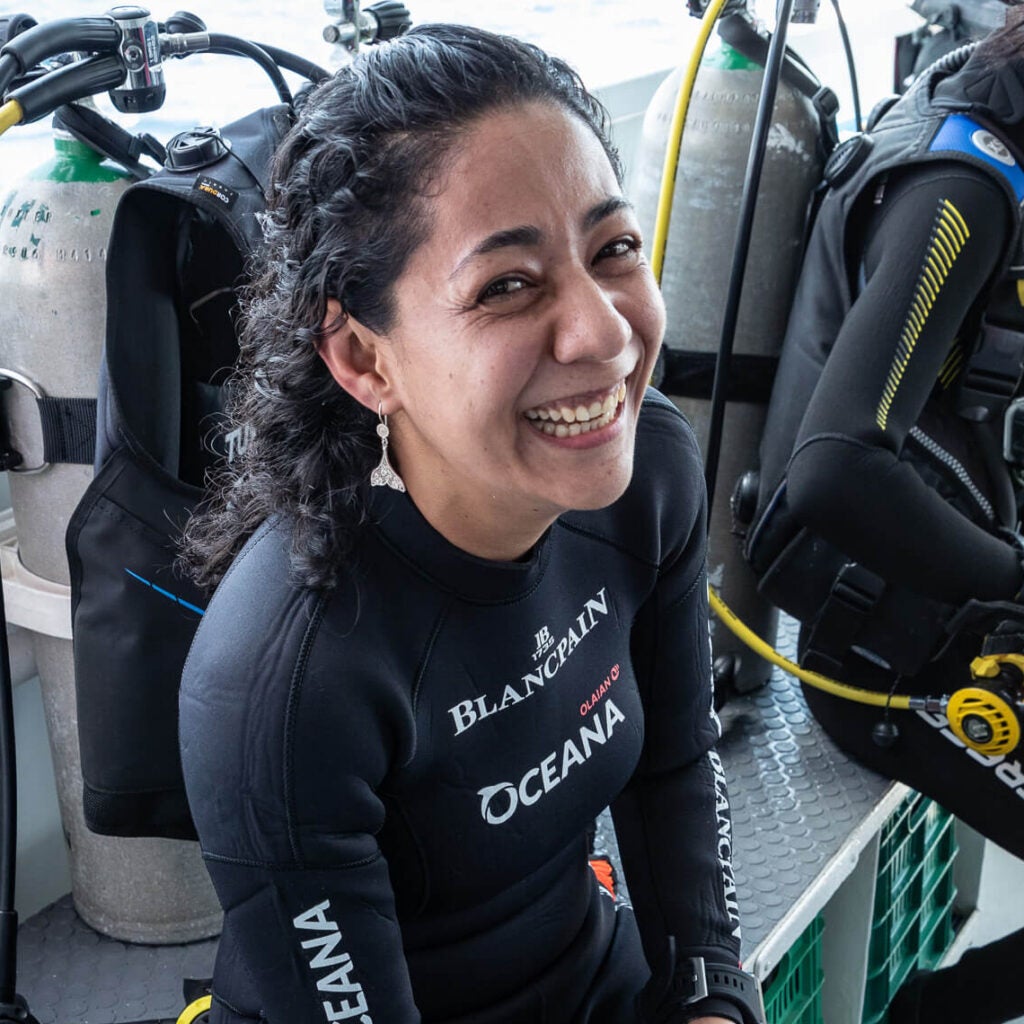November 25, 2024
Ask a Scientist: What happens on an Oceana expedition?
BY: Mariana Reyna
Exploring the depths of Bajos del Norte and Alacranes Reef in Mexico
Expeditions play a pivotal role in Oceana’s campaigns to safeguard our oceans. These scientific ventures help uncover the biological intricacies of largely unexplored sites, including critical habitats like coral reefs. Nowhere is this more evident than in the depths of Bajos del Norte and Alacranes Reef in Yucatán, Mexico — home to abundant marine life, including corals, sea turtles, whales, sharks, and hundreds of fish species. In August 2021 and May 2022, Oceana and its corporate partner Blancpain set out to explore these important ecosystems. Here’s a behind-the-scenes look at our expeditions.
Prep for success
Each journey commences with meticulously selecting scientists to board our vessel. For Oceana’s recent expeditions to Bajos del Norte and Alacranes Reef, our team included 11 scientists who are leaders in their fields, four filmmakers, two journalists, five Oceana staff, four divers, and about eight boat crew members. My job was to ensure that we collected all the necessary scientific data we’d need to show the significance of these coral reefs to ensure their protection — and stay safe in the process.
Once the team is assembled, the logistical groundwork begins. Expedition leaders, scientists, dive masters, photographers, and crew pour hours of preparation into mapping navigation routes, scheduling daily dive sites, and planning how to document the vibrant marine life they’ll encounter. Expeditions also require foresight, anticipating challenges such as inclement weather.
Setting sail

The day of departure dawns and there’s magic in the air as we prepare to visit ecosystems brimming with protection potential. We board the Caribbean Kraken, a 100-foot-long aluminum-hull liveaboard vessel and set sail before sunrise. Arriving at our first dive site, scientists and photographers plunge into the water with their equipment.
An Oceana expedition usually lasts about eight to 10 days. Over that time, the intensity of our underwater excursions grows. The scientists’ hard work, combined with the physical toll of diving multiple times a day and sleeping on a constantly moving boat, gradually adds to their physical exhaustion. Despite the demanding days, each night’s post-dinner gatherings in the boat’s dining room are filled with animated discussions about protecting these important habitats.
Not every expedition follows its intended course, however. We’ve encountered challenges like adverse weather conditions requiring us to return to shore, albeit slightly disoriented. During both expeditions to Bajos del Norte and Alacranes, we had to return two to three days earlier than expected due to hurricanes forming. Nevertheless, our top priority remains ensuring Oceana’s access to crucial data, essential for advocating for the preservation of these marine areas for the benefit of marine species and coastal communities.
The case for protection

Scientific expeditions provide invaluable insights into the ecological complexities of remote locales like Bajos del Norte and Alacranes Reef. Our discoveries revealed a connection between the two reefs: The survival of one depends on the other. In Bajos del Norte, we recorded 87 new species of invertebrates: 35 crustaceans, 30 mollusks, and 22 brittle stars. We also found 19 species of hard corals. In Alacranes Reef, we documented 33 reef-building coral species, vital to the future of the ecosystem.
Our findings from these two expeditions also showed how the region’s economically important fisheries depend on the condition of these reefs. We found that the reefs are in good health — warranting their protection for future generations and the fishing communities along the Yucatán Bank.
Expedition results in hand, we approached Mexico’s authorities with a proposal to designate Bajos del Norte as a new marine protected area (MPA). In January 2024, the Mexican government declared Bajos del Norte a National Park, thanks to the results of these two expeditions and scientific collaboration. Bajos del Norte is now the largest MPA in the Gulf of Mexico.
Why expeditions matter
In Mexico and around the world, Oceana’s scientific expeditions have proven instrumental in identifying biologically rich, yet vulnerable, sites, such as coral reefs. Despite the challenges we encounter — be it unpredictable weather or logistical hurdles — the rewards far outweigh the risks. Each expedition yields invaluable findings, informing policies aimed at protecting our oceans. Through research and advocacy, we strive to secure a better future for marine life and humanity alike.
Every time we start planning an expedition, I’m filled with excitement — and a hint of nerves. But when the awaited day arrives, my nerves fade into joy as the purpose of our mission comes to life and we step onto the vessel, ready to face whatever might come our way.

Dr. Mariana Reyna is an ocean and fisheries scientist and Oceana’s expedition leader in Mexico. She holds a Ph.D. in Environmental Science, a master’s degree in Coastal Oceanography, and has more than 10 years of experience developing and implementing conservation and climate change projects in the water and on land. Reyna led Oceana’s first ever at-sea expedition in Mexico.



